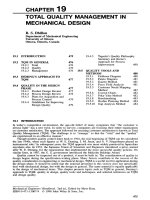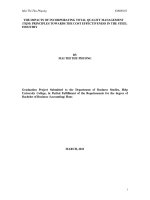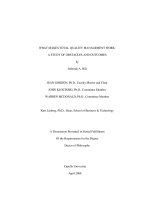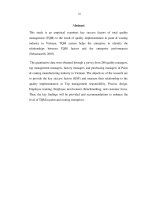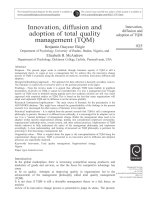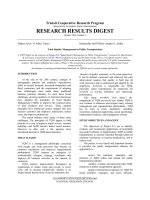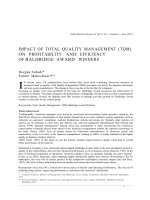Total Quality Management in Apparel Industry of Bangladesh
Bạn đang xem bản rút gọn của tài liệu. Xem và tải ngay bản đầy đủ của tài liệu tại đây (169.45 KB, 13 trang )
Topic: Total Quality Management in Apparel Industry of Bangladesh
1 | P a g e
Abstract:
Total quality management (TQM) managing process of good quality. Though this way, a
good quality product is find out. Plan, do, check and acts are major principle. In this system, a
quality management is control. These are explain, we would understand that plan is meaning
that how can plan so that this is not prevent or backward in this plan. Do is meaning that plan
is right or wrong. Check is meaning that this plan or do is exam. Acts is meaning that total
work is right or wrong. At this we understand that in this system, we can achieve for good
quality management. In good management, every fault will get published and good quality
product will get. Managing plan is very good and organization will grow up quickly with
good quality products or service.
Introduction:
Total Quality Management is a structured system for managing the quality of products.
Quality means customer needs is to be satisfied. It helps the customers to get quality products
or goods. At this the customer is satisfied. Customer always wants new products or goods
through the processes of design, specification, controlled manufacture and sale.
There are a number of factors on which quality fitness of garment industry is based such as -
performance, reliability, durability, visual and perceived quality of the garment. Quality
needs to be defined in terms of a particular framework of cost.
Garment industry collected raw materials for final finished garment. For textile and apparel
industry product quality is calculated in terms of quality and standard of fibers, yarns, fabric
construction, color fastness, surface designs and the final finished garment products.
1.Literature review:
[1Asked “what is quality?” one of our students replied “getting what you pay for.” Another
student added that to her, quality was “getting more than you paid for.” The oxford American
dictionary defines quality as “a degree or level of excellence”. Obviously quality can be
defined in many ways, depending on who is defining it and to what product or service it is
acceptable.] [2To some people, quality is goodness or luxury. To other, quality is durability,
beauty, labels or high prices. Clearly, consumers rely on a wide variety of cause to determine
whether products meet their quality standers.] [3To confront the challengers the apparel
industry could integrate by way of major technology breakthroughs. So what quality details
should you look for? The list can be lengthy but begin with this simple way.]
2 | P a g e
2.Meaning of quality:
[4Quality means customer needs is to be satisfied. Failure to maintain an adequate quality
standard can be unsuccessful. But maintaining an adequate standard of quality also costs
effort. From the first investigation to find out what the potential customer for a new product
really wants, through the processes of design, specification, controlled manufacture and sale.
There are a number of factors on which quality fitness of garment industry is based such as -
performance, reliability, durability, visual and perceived quality of the garment. Quality
needs to be defined in terms of a particular framework of cost.
Objectives:
I. To maximize the production of goods within the specified tolerances correctly the
first time.
II. To achieve a satisfactory design of the fabric or garment in relation to the level of
choice in design, styles, colors, suitability of components and fitness of product for
the market.]
3.Dimension of quality management:
The dimension of quality for a service differs somewhat for those of a manufactured product.
There are discussed following below. These are
[5Time and timelines: How long must a customer wait for service and is it completed on
time? For example, is an overnight package delivered overnight?
Completeness: Is everything the customer asked for provided? For example, is a mail order
from a catalogue company complete when delivered?
Consistency: Is the same label of service provided to each customer each time? Is your
newspaper delivered on time every morning?]
4.Quality Management System Evaluation:
[6The rising sub-contracting issues and improper quality processes are bringing more
obstacles to improving transparency and more reliable production processes.
As an accredited third-party service provider, we offer independent evaluation that helps your
garment manufacturers to develop a quality management system that meets international
standards and best practices.
Our QMS audit standard and scheme were developed through long-term collaborations with
leading players in the global textile and apparel markets.]
3 | P a g e
5.Quality Management Assurance for the Retailers:
[7Retailers sell a variety of consumer products and rely on their suppliers to provide them
quality products. However, retailers must have some way of verifying that they are receiving
products at quality levels they planned or specified. Retailers also should be able to specify
quality levels, if necessary. This book outlines various approaches available to retailers to
assure product quality. The book also covers other important topics like product safety,
product testing, end item inspection, product recalls, product liability, standards and
specifications, supplier quality system evaluation, supplier rating, supplier partnership,
customer returns and customer satisfaction.
6.Principle of total quality management:
The Quality System Requirements are based on the principle of PDCA Cycle.
6.A.Process Cycle:
1. Understanding the customers' quality requirements.
2. Organizing & training quality control department.
3. Ensuring proper flow of quality requirements to the QC department.
4. Ensuring proper flow of quality requirements to the Production Department.
5. Establishing quality plans, parameters, inspection systems, frequency, sampling
techniques, etc
6. Inspection, testing, measurements as per plan.
7. Record deviations
8. Feed back to Production Department.
4 | P a g e
9. Plan for further improvement.
6.B.Establishing the Quality Requirements:
The first step for quality control is to understand, establish & accept the customers' quality
requirements. This involves the following steps.
1. Getting customers specifications regarding the quality
2. Referring our past performance
3. Discussing with the Quality Control Department
4. Discussing with the Production Department
5. Giving the Feed Back to the customers
6. Receiving the revised quality requirements from the customers
7. Accepting the quality parameters
7.Quality Management control:
It becomes necessary to maintain the quality right from the production stage in order to
deliver a satisfactory final product to the consumer with the right quality which in turn results
in getting continuous orders from the same customers.
8.Importance of Quality Management Control :
Garment industry has a complex supply chain where garment makers source materials, stitch
garments and sell goods to retailers. Through buyers and retailers quality garments reach to
end user located all over the world. No wearers will buy a garment with poor quality and
visible defects. So buyers and retailer knowingly do not purchase a product that does not
meet the quality requirement. Quality conscious buyers have a strong quality inspection
system in place to avoid purchasing of defective goods.
• Factory may lose customers (buyers) as well as Brand Value
• Low motivated employees
• Need to work for extra hours
• Ultimately production cost will increase ]
5 | P a g e
9.Kind of quality management control:
Quality is very important to buyer or user and it is increasing day by day. Mainly two
processes are followed to control quality
1. Testing &
2. Inspection.
Inspection in reference to the apparel industry can be defined as the visual examination or
review of raw materials (like fabric, sewing threads, buttons, trims, etc).
9.A.Quality Inspection System:
[8There are four systems to justify the quality of garments/fabric. They are given below:
1. 4 point system
2. 10 point system
3. Graniteville “78″ system.
4. Dallas system.
But among them four point system is widely used. In our previous article we have discussed
about 4 point system.
Process of Garment Inspection System:
Confirmation of Quantity
↓
Confirmation of accessories
↓
Size spec inspection
↓
in side Inspection
↓
Outside Inspection
↓
Final Inspection
↓
Packing ]
6 | P a g e
9.B.Various Steps of Inspection & Quality Control:
The following levels are discussed at the Garment Making Department assuming that this
department is receiving the ready to cut dyed & finished fabrics from the Dyeing & Finishing
Department.
9.B.(1)Before or Pre-production Inspection:
The following parameters & defects are checked prior to cutting.
Shade Matching
Fabric Construction
Fabric Holes
Vertical & Horizontal Stripes
Knitting defects such as missing loops
Softness
Shrinkage
Matching of Rib, Collars & Cuffs
Yarn defects such as thick & thin
Dirt’s & Stains
GSM (grams per square meter)
Dyeing Levelness
9.B.(2)During Production Inspection:
Fabric defects
Collars & Cuffs matching
Stitching defects
Sewing threads matching
Dirt’s & Stains
Measurements
7 | P a g e
cutting patterns
Cutting shapes
Trims & Accessories
Labels
9.C.Before Production Inspection:
Many of the important parameters of Pre-productions, During productions & Final inspection
parameters. This is to ensure that wrong or major defective garments are not packed.
9.C(1)PACKING & ASSORTMENT
Wrong Model
Wrong Quantity
Missing labels & tags
Wrong Size & Color assortment
Wrong Folding
9.C(2) FABRIC DEFECTS
Uneven dyeing
Holes
Wrong Shade
Thick & Thin places
Dirt & Stains
Oil stains
Poor softness
Higher Shrinkage
9.C(3) SEWING DEFECTS
Needle holes & marks
Unbalanced sleeve edge
Unbalanced placket
8 | P a g e
Open seam
Puckering
Incorrect side shape
Broken & Missing stitch
Poor Ironing
Bottom hem bowing
Uneven neck shape
9.C(4) MEASUREMENT PROBLEM
Compare the garment measurements against the Customers' Measurement Charts.
Following are the some of the important garments' measurement aspects to be considered.
1. Garment length
2. Body width
3. Shoulder length
4. Arm hole
5. Arm Opening
6. Sleeve length
7. Placket length
8. Placket width
9. Neck width
10. Neck opening
11. Hemming width
12. Rib or Collar width
9.C(5) GENERAL DEFECTS
1. Shade variation within the garment parts
2. Shade variation between the garments
9 | P a g e
3. Defective printing
4. Defective embroidery
5. Defective buttons
10.Quality details in apparel:
[9There are following discuss about quality apparel. These are…
1. Fabric is the basic foundation of apparel. Fabric is woven by yarns which run up –and
down or across. When apparel is cut from the fabric.it should run up-down and across.
Sometimes apparel is not correctly, and actually causes clothing to twist around body. This is
called off-greensand cannot be corrected. Off-grain apparel is result of quality control during
the manufacturing process.
2. Manufactures sometimes use bias cut section cut costs. Bias cut apparel is exceptionally
difficult to sew, tends to stretch out of shape. Hang unevenly at the hem, or sag,
compromising quality.
3. Patterned fabrics should match along seemliness in both directions, across and up-and-
down. Aching indicates quality because of the additional fabric and labor involved in cutting
and sewing.
4. Colors should match between pieces and is not indictor of quality. Fabric, thread, zipper,
even elastic should match, function and be durable. Manufacturers know the performances
characteristics of each fabric and should base decagons on how well these pieces perform in
accordance with the fabric.
5. Seams within a garment should be securely sewn. Check to make sure threads have not
popped or ruptured along all seams. Seams with surging are more secure and higher quality
as long as the correct tension was used when sewn. Just be sure you tag along a seam to see if
it has enough tension to resist popping.
6. Design features within apparel can also help you judge quality.
7. Collars should be smooth as they lay against the body- corners should not roll or pucker
and each end of the collar the same length and shape.
8. Buttons should pass through the button the buttonhole, and be securely sewn to the fabric
10 | P a g e
9. Hook and loop tape should be securely sewn. The coarser the hooks and loops are, the
better the holding power of the tape. Be sure to lock the tape together before laundering to
prevent damage to other apparel in the wash load.do not iron
10. Fit of the garment to the wearer is the final indicator of a quality to the wearer is the final
indicator of a quality decision. Alterations if needed can be an additional expense. Be sure to
check the fit by sitting, working and bending with the garment on the body. If you have to
pull or tug at any area of a garment after moving, sitting or bending, the garment is
improperly sized for the wearer. Check the mirror looking at the front side and back for
horizontal wrinkles in the garments. There are no standard sizes in apparel sizes vary be
style.]
11.The cost of achieving good quality Management:
[10 The cost of quality management program is prevention cost and appraisal costs.
Prevention costs are the costs of trying to prevent poor quality products from reaching the
customer. Example of prevention costs include:
Quality planning costs: The costs of developing and implementing the quality management
program.
Product design costs: The costs of designing products with quality characteristics.
Process costs: The cost expended to make sure the productive process conforms to quality
specification.
Training costs: The costs of developing and putting on quality training programs for
employees and management.
Information costs: The costs of acquiring and maintaining data related to quality and the
development and analysis of reports on quality performance.]
Conclusion:
Wants, wants and more wants, every person say. Every person wants quality products or
services. For this, more company is ready to give quality product or service. If you want to
see your company, you need to give quality product. At this the company will stay more
days. If good quality products do not give, the company will lost. The managing quality
control gives always good quality product or service. Though total quality management,
Good quality products give possible. So quality management is not very good, at this quality
product or service get. So it is very important for apparel industry.
11 | P a g e
Reference
1. Operations management(book)/Writer-Roberta s. Russell and Bernard W. Taylor
111/page no-79
2. Apparel manufacturing sewn product analysis(book)/Writer- Ruth E. Glock and Grace
I. Kunz/page no-13
3. Changing trends in apparel industry(book)/Writer-N.S.Kaplan/page no-27-28
4. />manufacture1.asp
5. Operations management(book)/Writer-Roberta s. Russell and Bernard W. Taylor
111/page no-81
6. />7. />garments_2589.html
8. o/quality-inspection-system-in-garment-
industry/
9. Changing trends in apparel industry(book)/Writer-N.S.Kaplan/page no-28-30
10. Operations management(book)/Writer-Roberta s. Russell and Bernard W. Taylor
111/page no-99
12 | P a g e
13 | P a g e
